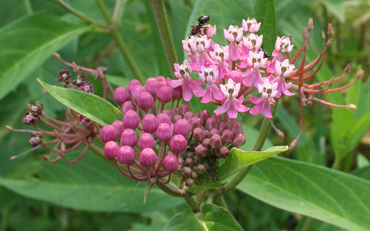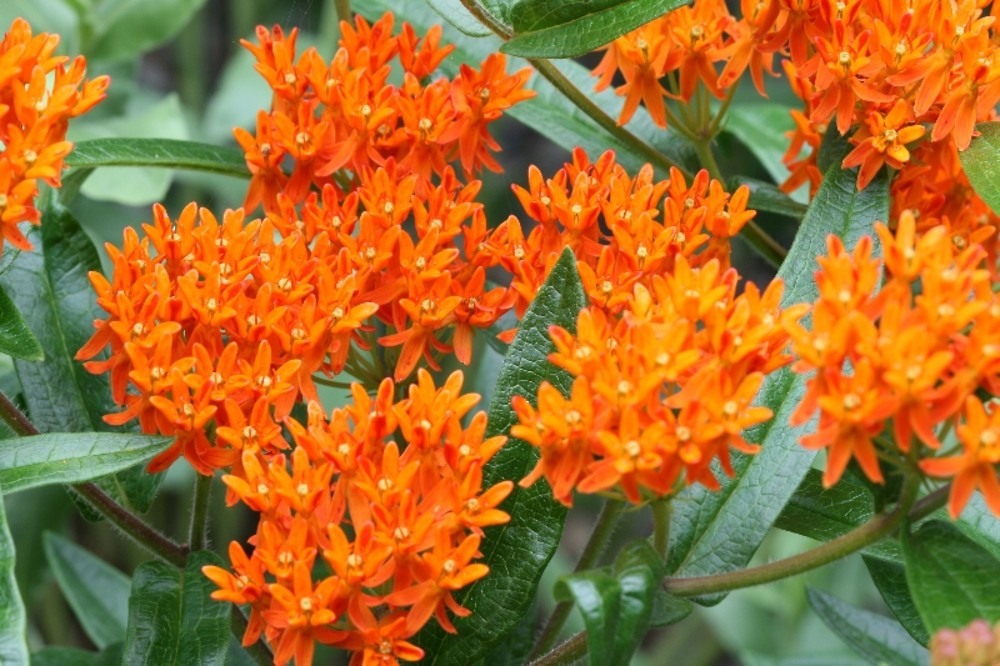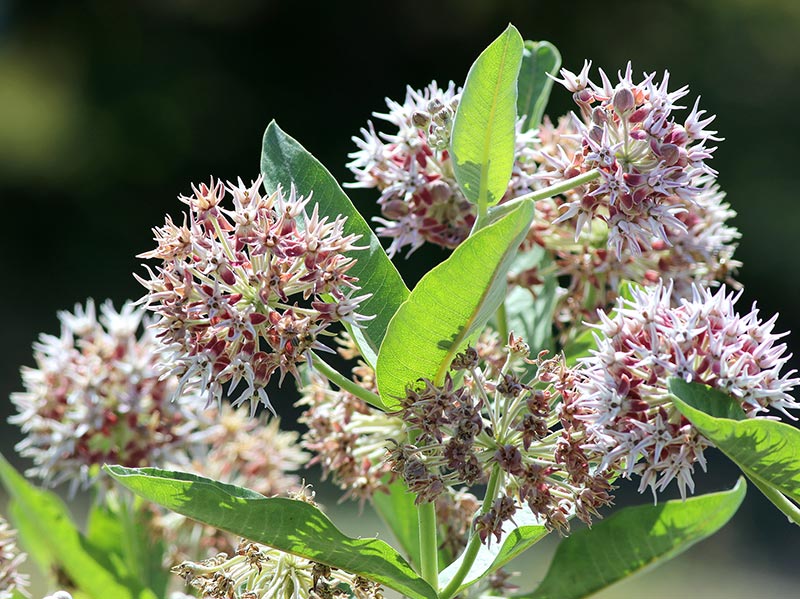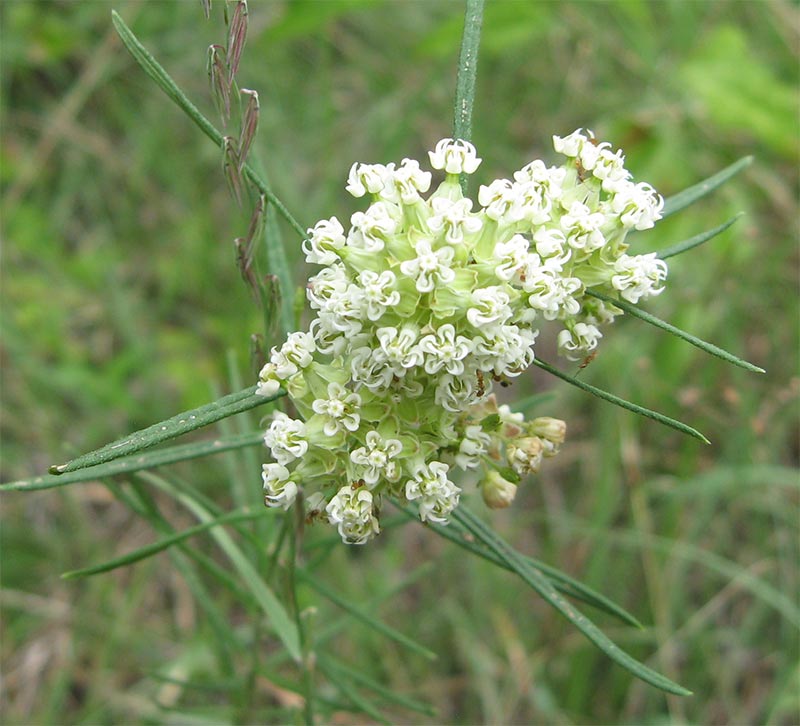
SCIENTIFIC NAME
DESCRIPTION
Milkweeds are a large group of plants with heights anywhere from 20 to 180 centimetres (0.5 foot to 6 feet) and flowers that range from white and greenish to pale pink and deep magenta.
Some shared traits of Canada’s milkweeds, however, are a large round or flat cluster of late spring or summer-blooming flowers. Their petals fold backwards on the stem and the centre of the flower is comprised of five hood-like structures within which is a protruding ‘horn’ as well as the plant’s nectar. Their leaves and stems typically have a milky sap, hence their name, Milkweed.
Ripe milkweed seed pods are elongated and, once hardened, open with a slit along one side to reveal many brown seeds attached to thin silky white fibres that fluff up to catch the wind and carry their seeds farther afield.
Many species have thick wide oval shaped leaves arranged oppositely along the stem although some have slightly or extremely narrow leaves as well as have an alternate or whorled arrangement on the stem. They are all generally pointy to some degree at both ends.
For a breakdown of Canada’s milkweed species, see below.
RANGE
Milkweeds are found in all provinces across Canada although they are not commonly found in Newfoundland and Labrador. They are not native to the northern regions including the territories.
HABITAT
Milkweeds grow in a variety of habitats from fields and forests to wet shorelines. See the list below of Canadian species and their preferred habitats.
DIET
BEHAVIOUR
undefinedPRIMARY ECOSYSTEM ROLES

Milkweed is the food source for Monarch Butterfly caterpillars who are able to ingest the bitter and poisonous compounds in milkweed sap. The caterpillars carry the toxins into adulthood where potential predators soon learn to avoid the bitterness of this orange and black butterfly.
A few other insects feed on milkweed leaves and rhizomes while many more drink nectar from the flowers. Birds such as Northern Orioles even use the strong plant fibres from last year’s milkweed stems to construct their nests while others take advantage of leftover silky seed tufts to line their nests.
Uses
Milkweed has helped people for centuries…and still does to this day!
The hollow silky tufts that carry the seeds on the wind “is six times more buoyant than cork and five times as warm as wool”, according to William Cullina, author of Growing and Propagating Wildflowers of the United States and Canada. This buoyancy led to its use in the Second World War when the Allies’ supply of stuffing for lifejackets was cut off and schoolchildren were recruited to gather milkweed silk to use as a replacement.
As for its insulation qualities, a Canadian company is currently producing winter coats with these milkweed fibres for warmth and the automotive industry is finding potential in milkweed for sound reduction for both cars and ambulances. In this regard, the fluff is especially appealing as it is lightweight and would therefore require less fuel to drive than other, heavier, materials.

Milkweed silk is also being recognized for its ability to absorb oil but not water, making it an efficient and natural way to respond to oil spills.
As a result of this increasing interest in milkweed down, many Quebec farms are now growing milkweed crops.
Milkweed stems, with their strong fibres, have been used by Aboriginal peoples to make ropes and bowstrings while empty pods are used by modern day parents, educators for crafts and both stem and pod are employed in flower arrangements.
Milkweeds have also been used medicinally for centuries in treating infections, warts and other ailments. This could be why they were given the name Asclepias in honour of the Greek god of medicine Asklepios (Asclepius).
The milky sap which contains latex can be irritating to the skin although has been used as rubber. Various parts of milkweed have been used for food, although is toxic if not correctly prepared.
Photo Gallery
Species
Here are the 14 species of milkweed in Canada. One species, Asclepias variegata, is now presumed to be Extirpated (no longer growing there) from its native range in Ontario.
Scientific name
A. incarnata
Range
Manitoba, Ontario, Quebec, New Brunswick, Nova Scotia, PEI
Habitat
It grows in a variety of moist places such as wet meadows and woods, ditches and along shorelines.
Appearance
(90 to 150 cm – 3 to 5 feet) Swamp Milkweed’s flat cluster of flowers are a deep pink and often two toned from the petals to the hoods. Leaves are somewhat narrow and opposite along the stem.
Scientific name
A. tuberosa
Range
Southern Ontario and southwest Quebec
Habitat
Butterfly Milkweed is found in areas with light soils and good drainage such as open woods, hillsides and prairies.
Appearance
(60 to 90 cm – 2 to 3 feet) Flowers are a brilliant orange in a flat cluster, leaves are narrow and alternate on the stem.
Notes
This plant was used medicinally to treat respiratory conditions. Unlike the other milkweed species, its sap is clear and less abundant. If you live in a cooler climate and want to grow it in your garden, consider mulching the plant to help it survive the winter.
Scientific name
A. speciosa
Range
British Columbia, Alberta, Saskatchewan, Manitoba
Habitat
Showy Milkweed can be found in damp grasslands, roadsides, along streams and forest edges.
Appearance
45 to 90 cm - 1.5 to 3 feet) Pale pink flowers (sometimes greenish) grow in rounded clusters and are sweet smelling. Their hoods are long and pointy, giving them a starry look. Leaves are opposite and widely oval but can be narrower.
Scientific name
A. verticillata
Range
Saskatchewan, Manitoba, Ontario
Habitat
Showy Milkweed can be found in damp grasslands, roadsides, along streams and forest edges.
Appearance
(30 to 90 cm – 1 to 3 feet) This milkweed has fragrant white flowers that bloom later in the summer than other milkweeds. Its leaves are very narrow and grow in whorls along the stem although they can stagger as the plant matures.
Scientific name
A. ovalifolia
Range
British Columbia, Alberta, Saskatchewan, Manitoba, northwest Ontario
Habitat
Well drained or sandy areas such as open woods, woodland edges, thickets and roadsides and sometimes in moist areas
Appearance
(20 to 60 cm – 0.5 to 2 feet) White fragrant flowers with greenish or a pale purple tinge bloom in small clusters. Its leaves are opposite, large and oval or lanceolate.
Scientific name
A. exaltata
Range
Southern Ontario and southwest Quebec
Habitat
Poke Milkweed is found in open woodlands, forest edges and roadsides.
Appearance
(60 to 150 cm – 2 to 5 feet) Flowers white to pale pink or purple and tend to droop. Leaves are oval or egg-shaped, opposite and their edges are sometimes wavy.
Scientific name
A. lanuginosa
Range
Southern Manitoba (rare)
Habitat
Open prairies and woods
Appearance
(25 to 35 cm - 10 to 14 inches) This milkweed is a short plant with white or greenish flowers. Petals can flare a bit outwards at the tip as with most milkweeds or be straight to the degree that they are flat and tight against the stem. Their hoods are also different to most milkweeds in not being taller than the centre of the plant and tight rather than rounded. Stems and leaves have wooly hairs. Leaves are somewhat narrow and typically alternately arranged on the stem.
Scientific name
A. hirtella
Range
Southern Ontario (rare)
Habitat
Fields, roadsides and prairies
Appearance
(50 to 100 cm – 2 to 3.5 feet) Tall Green Milkweed flowers are white to greenish and, similar to A. viridiflora below, the flowers are tight and narrow looking. Its leaves are very narrow and alternate on the stem or are whorled.
Scientific name
A. viridiflora
Range
British Columbia, Alberta, Saskatchewan, Manitoba, Ontario
Habitat
Green Milkweed can be found in a variety of sandy or rocky areas, fields, grasslands, meadows as well as damp areas like marshes.
Appearance
(30 to 60 cm - 1 to 2 feet) Rounded clusters of pale green flowers tend to hang downwards. Green Milkweed’s petals and hoods are tighter than other milkweed flowers, with a narrower appearance than typical milkweed flowers. Leaves can be alternate or opposite and are oval on moister soils but can be very narrow when growing in drier habitats.
Scientific name
A. purpurascens
Range
Southern Ontario (rare)
Habitat
Woodland edges, roadsides, dry fields
Appearance
(45 to 75 cm - 1.5 to 2.5 feet) Purple Milkweed has deep pink flowers and oblong leaves arranged oppositely along the stem.
Scientific name
A. quadrifolia
Range
Southern Ontario (rare)
Habitat
Four-leaved Milkweed can be found in moist or dry woodlands, forest edges, ridges.
Appearance
(30 to 75 cm – 1 to 2.5 feet) Fragrant flowers are white to pale pink, leaves are oval or lanceolate and are in opposite pairs or whorled along the stem. It has a more delicate look than Common Milkweed.
Scientific name
A. variegata
Range
Southern Ontario (Extirpated)
Habitat
While these species of milkweed have vanished from the Canadian landscape, Variegated Milkweed would normally be found in open woods, woodland edges and roadsides typically where there is some shade.
Appearance
(45 to 90 cm - 1.5–3 feet) Round clusters of fragrant bright white flowers have a purple-red ring where the base of the petals meet the flower’s centre. Oval leaves are oppositely arranged on the stem.
Scientific name
Asclepias syriaca
Range
Saskatchewan, Manitoba, Ontario, Quebec, New Brunswick, Nova Scotia, Prince Edward Island, Newfoundland and Labrador
Habitat
It can be found in fields and along roadsides.
Appearance
(90 to 150 cm – 3 to 5 feet) Flowers are heavily scented, pale pink (sometimes greenish) and grow in a large round cluster. Leaves are wide, oval and opposite on the stem.
Notes
Common Milkweed is one of the more aggressively spreading species but is also now being grown for its industrial uses as noted above.
- 0
- 1
- 2














